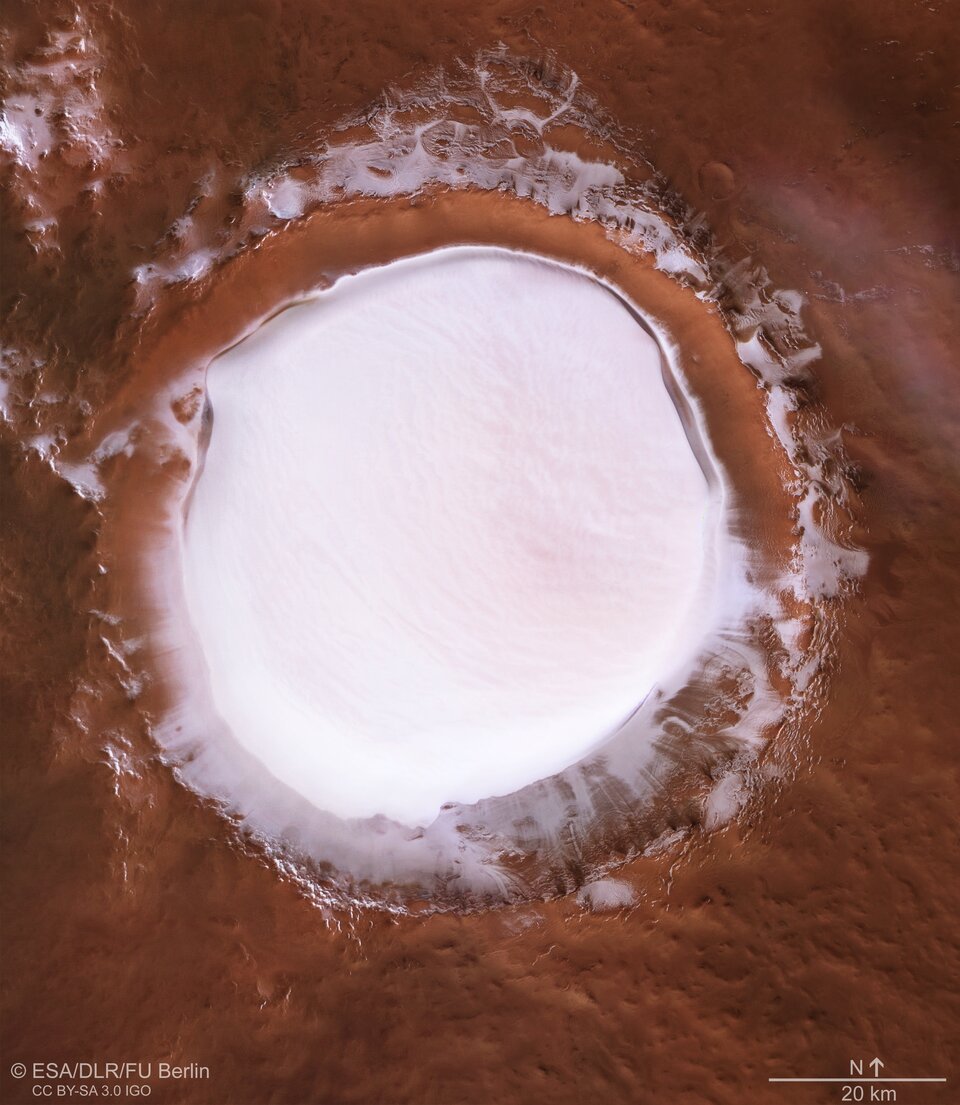We love flyover videos from other worlds. These stunning videos, created from imagery gathered by orbiting spacecraft, can give us a sense of what it would be like to fly in an airplane on another planet.
This latest flyover video from the European Space Agency's Mars Express spacecraft, provides a stunning view of one of Mars' most eye-popping craters.
This movie was created using an imagery from Mars Express' High Resolution Stereo Camera (HRSC).
The images are normally taken looking straight down (nadir), and the video combines topography information from the stereo channels of HRSC to generate a three-dimensional landscape, which was then recorded from different perspectives, as with a movie camera, to render the flight shown in the video.
Korolev Crater is 82 kilometers (50 miles) across and at least 2 km (1.25 miles) deep. This well-preserved crater is located the northern lowlands of Mars, just south of a large patch of dune-filled terrain that encircles part of the planet's northern polar cap (known as Olympia Undae).
 Overhead view of Korolev Crater on Mars. (ESA/DLR/FU Berlin)
Overhead view of Korolev Crater on Mars. (ESA/DLR/FU Berlin)
That's not snow you're seeing, but this crater is constantly filled with water ice, and its central mound is about 1.8 kilometers (1.1 miles) thick all year round. It's one of the largest reservoirs of non-polar ice on Mars.
This view reminds me of a flight I took where I flew over Meteor Crater in Arizona USA. But for comparison, Meteor Crater is less than a mile across (.737 miles/1.186 km) and just 560 feet (170 m) deep.
You may be thinking, how can this ice remain stable in Korolev Crater; doesn't water ice sublimate away in Mars thin atmosphere?
Just like dry ice does here on Earth, water ice on Mars usually goes from solid to gas with the low atmospheric pressure. (Mars has approximately 8 millibars while on Earth the average, atmospheric pressure at sea level is 1013.25 millibars, or about 14.7 pounds per square inch.)
But temperature can influence ice stability as well. Water ice is permanently stable within the Korolev Crater because the deepest part of this depression acts as a natural cold trap.
The scientists at ESA explain that the air above the ice cools and is thus heavier compared to the surrounding air: since air is a poor conductor of heat, the water ice mound is effectively shielded from heating and sublimation.
The name of the crater may be familiar. It's named after Russian rocket engineer and spacecraft designer Sergei Pavlovich Korolev (1907-1966). He developed the first Russian intercontinental rocket R7, the precursor of the modern Soyuz rockets that are still operated today.
With his rocket and spacecraft design, he was also responsible for the first human-made satellite (Sputnik in 1957) and for the first human spaceflight (Yuri Gagarin in 1961).
Find out more about Mars Express and Korolev Crater here and here.
Here's a list of the flyover videos we've posted on Universe Today.
This article was originally published by Universe Today. Read the original article.
"filled" - Google News
July 04, 2020 at 04:54PM
https://ift.tt/2ZD2Gs3
Gorgeous New Footage Lets You Fly Over a Vast, Ice-Filled Crater on Mars - ScienceAlert
"filled" - Google News
https://ift.tt/2ynNS75
https://ift.tt/3feNbO7
Bagikan Berita Ini














0 Response to "Gorgeous New Footage Lets You Fly Over a Vast, Ice-Filled Crater on Mars - ScienceAlert"
Post a Comment